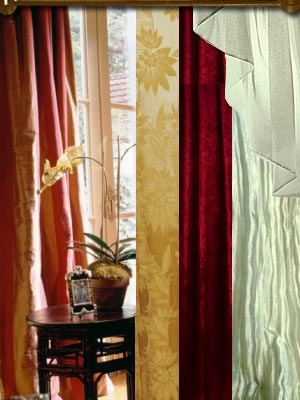Drape Fabric

The textural elements of drape fabrics offer a variety of colors, patterns, styles, designs, weights to suit any kind of decor elements. Find out the pros and cons of different drape fabrics to make the right choice.
Drape fabric
While natural fabrics offer 'breathability', synthetic fabrics can boast of 'durability'. You can use a combination of natural – synthetic blend for drape fabrics. This allows you to combine the strength of the synthetics with the desirable qualities found in the naturals.
Drape fabric guide
Cotton: This is probably the strongest of natural fabrics. It is used extensively for drape curtains as it is versatile. It dyes well and comes in a wide range of color choices. It allows air to flow through the fabric. Cotton as a drape fabric is ideally suited for rooms where people sit for long duration of time such as the family rooms. Cotton drape fabric also enhances the comfort of furniture and is widely used in furnishings and upholstery.
However, cotton lacks durability. It would be wise to use cotton-synthetic mix – (with polyester fabric – 60% cotton, 40% polyester) to combine the breathability with the durability of polyester.
Silk: Silk is valuable and versatile at once. Silk comes in rich hues like burgundy, plum and rust. Such drapes help create a luxurious atmosphere. Silk is gorgeous fabric for window drapes. It is long wearing and affords durability. It is interesting to note that some of the finest oriental rugs that have lasted for several hundreds of years are made of silk. Silk is also widely used as upholstery fabric. Silk feels cool and is slick. Silk also comes in a variety of weight – from light to medium to heavy.
There are different types in silk. While 'silk brocade' woven with embossed design is heavy and rich and can be used for ornate drapes and decors, 'silk charmeuse' is stiffer silk. Such drape fabric comes lined with crepe for drape curtains at windows. 'Chiffon' is light silk with a breezy look and can be combined with another fabric when used as drape fabric. The Italian 'Doupion' or 'Dupioni' is pure silk and available in myriad colors in best natural form. However it is very expensive. It is best suited for drape curtains and upholstery used for special occasions like marriages and similar celebrations.
'Silk satin' gives a shiny, glossy finish which can be used in ornate drapery. Silk is susceptible to sun damage. It is therefore not advised to use silk in drapes that are constantly exposed to sun or bright light. Care should also be taken to maintain silk draperies. Hand wash is better than dry cleaning such drape fabrics. Sometimes lesser- quality silk tends to shrink and discolor during hand wash. Therefore the reaction of silk to water has to be checked first even before hand wash.
Wool: This fabric is natural and is used extensively in rugs and carpets for its durability. It is warm and most suited for cool climes. But some people exhibit allergic reactions to wool. Wool is hard wearing and excellent for wall to wall carpeting. Wool is also wonderful for small floor coverings, especially near the fireplace at homes. Wool upholstery lasts for generations.
Linen: This drape fabric is stain resistant. It has a fine luster. It is also used for table drape. Linen fabric is light, casual and natural. It is especially suitable for spring and summer. Linen 'wrinkles' and it should be used with a lining material when used for window drapes.
Velvet: This fabric is too thick to gather well for a drape, as it does not hand well. However it is extensively used in upholstery and furniture cover. Velvet fabric is shiny, comes in bright colors and attractive to look at.
Acrylic: This synthetic fabric is often blended with natural fiber to add durability for drapes. It is color fast and stain resistant. Acrylic fabric also has sun resistant qualities which are not found in cotton, linen and other natural fabrics.
Rayon: This fabric can be used as window drapes in low humid areas as rayon is humid sensitive.
Nylon: This is a 'no stain' fabric with continuous filament. But it cannot 'breathe' like cotton. Because of the solidity of the filament, nylon fabric gathers and hangs well. It could be useful in opaque curtains used for room dividers.
Polyester: This synthetic fabric is very popular as drape fabric and is widely used in blend with cotton. It is fade resistant. But polyester is harder to clean.
Acetate: Here is another fabric which is long wearing and is less affected by humidity unlike rayon. This is much softer with no 'wrinkles' like linen. It is used in blended drapes for doors and windows.
Choosing drape fabric
Fabrics used in drapes can be sheer light, medium or heavy, lined or unlined. While sheer light fabric has plenty of movement, the heavier fabrics hang best although allowing little movement. For lighter drape fabrics to hang better, a second fabric is used as lining material. This helps to maintain the pleats of curtains and give a shape to the drape. This also helps insulate against light. Fabrics like voile, lace, polyester are too slippery to hold a drape. Therefore lining is often provided.
Very light fabrics like fine cotton, muslin and loose silk could be combined to ideally act together and hold the shape of the drape. Medium fabrics like wool, damask, brocade, cotton and chenille fall well. There is a drape fabric to suit every need. Fabrics are available in a wide variety of price in keeping with the quality.
Designer drape fabric
Popular drape designers: Some leading names under this category are Laura Ashley, Ralph Lauren, Waverley, and Robert Allen. These fabrics are not heavily priced. They are in popular demand and widely available in national departmental shops. Limited in selection, they are not exclusive fabrics.
Exclusive drape designers: Rogers and Gottigon, Manual Conoves, Beaumont and Fletcher are noted names here. These designs get featured in television shows and in home shopping magazines, boutiques and in decorating shops. They are more expensive than popular drapes.
Luxury drape designers: Chanel Valentino, Yves St.Laurent are lead names in this category. These are special drape fabrics for exclusively designed interiors. These are high quality fabrics such as silks, linen and Egyptian cotton, with custom designed patterns and designs. Exclusive colors are available. But this is an extremely expensive option.
Designer drape fabrics cost anywhere between $ 15 per yard to $ 250 per yard. While choosing a fabric for drape one should bear the following facts in mind:
- Often drape fabric is chosen to match the paint color of the room.
- The textile color in the room can work wonders on your mood. Drapes can change a dull room into an exciting one.
- Drape fabric have to be chosen in accordance with the use of the room. For instance, silk lace is best choice for rooms that see a lot of activities. For kid's room, woven materials like denim, chenille fabrics can be used.
- Drapes help to block out the light during the day. Also from the privacy point of view, heavy drapes prevent people peeping into the house. Heavy drapes or drapes with lining that can block light should be used in such places.
- Drape fabric should also complement your window, art, furniture and the decor in the room.
- Sometimes drape fabric that come in a variety of colors can be rotated between various rooms. They can be changed seasonally.
- Drape fabrics that control light are suitable for late morning or for an afternoon sleeper and can be used in such bedrooms.
- The drape can either blend into the background quality or make a powerful statement of its own reflecting one's personal style.
Nowadays fabric themes are available. Some of the themes are vintage, Hawaiian, African, Western, baby, novelty, tropical, oriental, contemporary and sports. Accessories such as shells, mirrors, pearls, buttons and embroidery, dyed and painted work can be used to add richness and elegance to the drape. With little imagination and eye for possibilities, drape fabric can be used in different styles combining practicality and style at once.
Top of the Page: Drape Fabric
Tags:#drape fabric #drape fabric guide
 Home and Garden
Home and Garden Wallpaper Mural
Venetian Blinds
Wrought Iron Furniture
Coffee Table
Table Linen
Beveled Mirror
Platform Beds
Rug Carpet
Home Furnishing Idea
Home Improvement Tips
Drape Fabric
Shower Curtain
Window Curtain
Kitchen Curtain
Discount Home Furnishing Tips
Kitchen Remodeling Idea
Upholstery Fabric
Slipcover
Home Garden Design
Lower Energy Bills
Home Office Furniture
Top of the Page: Drape Fabric
Popularity Index: 100,991

